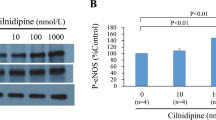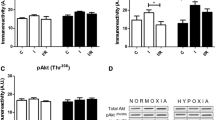Abstract
Activation of either the A1 adenosine receptor (A1R) or the A3 adenosine receptor (A3R), by their specific agonists CCPA and Cl-IB-MECA, respectively, protects cardiac cells in culture against ischemic injury. Yet the full protective mechanism remains unclear. In this study, we therefore examined the involvement of p38 mitogen-activated protein kinase (MAPK) and extracellular signal-regulated kinases (ERK) phosphorylation in this protective intracellular signaling mechanism. Furthermore, we investigated whether p38 MAPK phosphorylation occurs upstream or downstream from the opening of mitochondrial ATP-sensitive potassium (KATP) channels. The role of p38 MAPK activation in the intracellular signaling process was studied in cultured cardiomyocytes subjected to hypoxia, that were pretreated with CCPA or Cl-IB-MECA or diazoxide (a mitochondrial KATP channel opener) with and without SB203580 (a specific inhibitor of phosphorylated p38 MAPK). Cardiomyocytes were also pretreated with anisomycin (p38 MAPK activator) with and without 5-hydroxy decanoic acid (5HD) (a mitochondrial KATP channel blocker). SB203580 together with the CCPA, Cl-IB-MECA or diazoxide abrogated the protection against hypoxia as shown by the level of ATP, lactate dehydrogenase (LDH) release, and propidium iodide (PI) staining. Anisomycin protected the cardiomyocytes against ischemic injury and this protection was abrogated by SB203580 but not by 5HD. Conclusions Activation of A1R or A3R by CCPA or Cl-IB-MECA, respectively, protects cardiomyocytes from hypoxia via phosphorylation of p38 MAPK, which is located downstream from the mitochondrial KATP channel opening. Elucidating the signaling pathway by which adenosine receptor agonists protect cardiomyocytes from hypoxic damage, will facilitate the development of anti ischemic drugs.







Similar content being viewed by others
References
Murry CE, Jennings RB, Reimer KA (1986) Preconditioning with ischemia: a delay of lethal cell injury in ischemic myocardium. Circulation 74:1124–1136
Bolli R (2007) Preconditioning: a paradigm shift in the biology of myocardial ischemia. Am J Physiol 292:H19–H27
Cohen MV, Downey JM (2009) Adenosine at reperfusion: a conundrum ready to be resolved. J Am Coll Cardiol 53:718–719
Auchampach JA, Jin X, Moore J, Wan TC, Kreckler LM, Ge ZD, Narayanan J, Whalley E, Kiesman W, Ticho B, Smits G, Gross GJ (2004) Comparison of three different A1 adenosine receptor antagonists on infarct size and multiple cycle ischemic preconditioning in anesthetized dogs. J Pharmacol Exp Ther 308:846–856
Ge ZD, Peart JN, Kreckler LM, Wan TC, Jacobson MA, Gross GJ, Auchampach JA (2006) Cl-IB-MECA [2-chloro-N6-(3-iodobenzyl)adenosine-5’-N-methylcarboxamide] reduces ischemia/reperfusion injury in mice by activating the A3 adenosine receptor. J Pharmacol Exp Ther 319:1200–1210
Hochhauser E, Kaminski O, Shalom H, Leshem D, Shneyvays V, Shainberg A, Vidne BA (2004) Role of adenosine receptor activation in antioxidant enzyme regulation during ischemia-reperfusion in the isolated rat heart. Antioxid Redox Signal 6:335–344
Gross GJ (2000) The role of mitochondrial KATP channels in cardioprotection. Basic Res Cardiol 95:280–284
Pain T, Yang XM, Critz SD, Yue Y, Nakano A, Liu GS, Heusch G, Cohen MV, Downey JM (2000) Opening of mitochondrial K(ATP) channels triggers the preconditioned state by generating free radicals. Circ Res 87:460–466
Shneyvays V, Leshem D, Mamedova LK, Shainberg A (2003) Activation of adenosine A1 and A3 receptors protects mitochondria during hypoxia in cardiomyocytes by distinct mechanisms. In: Dhalla NS, Takeda N, Singh M, Lukas A (eds) Myocardial ischemia and preconditioning. Kluwer Academic Publishers, Boston, pp 347–364
Barancik M, Htun P, Strohm C, Kilian S, Schaper W (2000) Inhibition of the cardiac p38-MAPK pathway by SB203580 delays ischemic cell death. J Cardiovasc Pharmacol 35:474–483
Bassi R, Heads R, Marber MS, Clark JE (2008) Targeting p38-MAPK in the ischaemic heart: kill or cure? Curr Opin Pharmacol 8:141–146
Bogoyevitch MA, Gillespie-Brown J, Ketterman AJ, Fuller SJ, Ben-Levy R, Ashworth A, Marshall CJ, Sugden PH (1996) Stimulation of the stress-activated mitogen-activated protein kinase subfamilies in perfused heart. p38/RK mitogen-activated protein kinases and c-Jun N-terminal kinases are activated by ischemia/reperfusion. Circ Res 79:162–173
Sanada S, Kitakaze M (2004) Ischemic preconditioning: emerging evidence, controversy, and translational trials. Int J Cardiol 97:263–276
Beguin PC, Belaidi E, Godin-Ribuot D, Levy P, Ribuot C (2007) Intermittent hypoxia-induced delayed cardioprotection is mediated by PKC and triggered by p38 MAP kinase and Erk1/2. J Mol Cell Cardiol 42:343–351
Nakano A, Baines CP, Kim SO, Pelech SL, Downey JM, Cohen MV, Critz SD (2000) Ischemic preconditioning activates MAPKAPK2 in the isolated rabbit heart: evidence for involvement of p38 MAPK. Circ Res 86:144–151
Ballard-Croft C, Kristo G, Yoshimura Y, Reid E, Keith BJ, Mentzer RM Jr, Lasley RD (2005) Acute adenosine preconditioning is mediated by p38 MAPK activation in discrete subcellular compartments. Am J Physiol 288:H1359–H1366
Lochner A, Genade S, Hattingh S, Marais E, Huisamen B, Moolman JA (2003) Comparison between ischaemic and anisomycin-induced preconditioning: Role of p38 MAPK. Cardiovasc Drugs Ther 17:217–230
Yoshimura Y, Kristo G, Keith BJ, Jahania SA, Mentzer RM Jr, Lasley RD (2004) The p38 MAPK inhibitor SB203580 blocks adenosine A(1) receptor-induced attenuation of in vivo myocardial stunning. Cardiovasc Drugs Ther 18:433–440
Zhao TC, Hines DS, Kukreja RC (2001) Adenosine-induced late preconditioning in mouse hearts: role of p38 MAP kinase and mitochondrial K(ATP) channels. Am J Physiol Heart Circ Physiol 280:H1278–H1285
Hochhauser E, Leshem D, Kaminski O, Cheporko Y, Vidne BA, Shainberg A (2007) The protective effect of prior ischemia reperfusion adenosine A1 or A3 receptor activation in the normal and hypertrophied heart. Int Cardiovasc Thorac Surg 6:363–368
Shneyvays V, Leshem D, Zinman T, Mamedova LK, Jacobson KA, Shainberg A (2005) Role of adenosine A1 and A3 receptors in regulation of cardiomyocyte homeostasis following mitochondrial respiratory chain injury. Am J Physiol Heart Circ Physiol 288:H2792–H2801
Shainberg A, Yitzhaki S, Golan O, Jacobson KA, Hochhauser E (2009) Involvement of UTP in protection of cardiomyocytes from hypoxic stress. Can J Physiol Pharmacol 87:287–299
Yitzhaki S, Shneyvays V, Jacobson KA, Shainberg A (2005) Involvement of uracil nucleotides in protection of cardiomyocytes from hypoxic stress. Biochem Pharmacol 69:1215–1223
Nieminen AL, Gores GJ, Bond JM, Imberti R, Herman B, Lemasters JJ (1992) A novel cytotoxicity screening assay using a multiwell fluorescence scanner. Toxicol Appl Pharmacol 115:147–155
Maulik N, Watanabe M, Zu YL, Huang CK, Cordis GA, Schley JA, Das DK (1996) Ischemic preconditioning triggers the activation of MAP kinases and MAPKAP kinase 2 in rat hearts. FEBS Lett 396:233–237
Headrick JP, Willems L, Ashton KJ, Holmgren K, Peart J, Matherne GP (2003) Ischaemic tolerance in aged mouse myocardium: the role of adenosine and effects of A1 adenosine receptor overexpression. J Physiol 549:823–833
Cohen MV, Downey JM (2008) Adenosine: trigger and mediator of cardioprotection. Basic Res Cardiol 103:203–215
Wan TC, Ge ZD, Tampo A, Mio Y, Bienengraeber MW, Tracey WR, Gross GJ, Kwok WM, Auchampach JA (2008) The A3 adenosine receptor agonist CP-532, 903 [N6-(2, 5-dichlorobenzyl)-3’-aminoadenosine-5’-N-methylcarboxamide] protects against myocardial ischemia/reperfusion injury via the sarcolemmal ATP-sensitive potassium channel. J Pharmacol Exp Ther 324:234–243
Carroll R, Yellon DM (2000) Delayed cardioprotection in a human cardiomyocyte-derived cell line: the role of adenosine, p38MAP kinase and mitochondrial KATP. Basic Res Cardiol 95:243–249
Nagy N, Shiroto K, Malik G, Huang CK, Gaestel M, Abdellatif M, Tosaki A, Maulik N, Das DK (2007) Ischemic preconditioning involves dual cardio-protective axes with p38MAPK as upstream target. J Mol Cell Cardiol 42:981–990
Ping P, Murphy E (2000) Role of p38 mitogen-activated protein kinases in preconditioning: a detrimental factor or a protective kinase? Circ Res 86:921–922
Maulik N, Yoshida T, Zu YL, Sato M, Banerjee A, Das DK (1998) Ischemic preconditioning triggers tyrosine kinase signaling: a potential role for MAPKAP kinase 2. Am J Physiol 275:H1857–H1864
Mubagwa K, Flameng W (2001) Adenosine, adenosine receptors and myocardial protection: an updated overview. Cardiovasc Res 52:25–39
Zhang Y, Gu EW, Zhang J, Chen ZW (2007) Role of p38 mitogen-activated protein kinases in cardioprotection of morphine preconditioning. Chin. Med. J. (Engl.) 120:777–781
Weinbrenner C, Liu GS, Cohen MV, Downey JM (1997) Phosphorylation of tyrosine 182 of p38 mitogen-activated protein kinase correlates with the protection of preconditioning in the rabbit heart. J Mol Cell Cardiol 29:2389–2391
Ma XL, Kumar S, Gao F, Louden CS, Lopez BL, Christopher TA, Wang C, Lee JC, Feuerstein GZ, Yue TL (1999) Inhibition of p38 mitogen-activated protein kinase decreases cardiomyocyte apoptosis and improves cardiac function after myocardial ischemia and reperfusion. Circulation 99:1685–1691
Mackay K, Mochly-Rosen D (1999) An inhibitor of p38 mitogen-activated protein kinase protects neonatal cardiac myocytes from ischemia. J Biol Chem 274:6272–6279
Sun HY, Wang NP, Halkos M, Kerendi F, Kin H, Guyton RA, Vinten-Johansen J, Zhao ZQ (2006) Postconditioning attenuates cardiomyocyte apoptosis via inhibition of JNK and p38 mitogen-activated protein kinase signaling pathways. Apoptosis 11:1583–1593
Yellon DM, Downey JM (2003) Preconditioning the myocardium: from cellular physiology to clinical cardiology. Physiol Rev 83:1113–1151
Loubani M, Galinanes M (2002) Pharmacological and ischemic preconditioning of the human myocardium: mitoK(ATP) channels are upstream and p38MAPK is downstream of PKC. BMC Physiol 2:10
Loubani M, Hassouna A, Galinanes M (2004) Delayed preconditioning of the human myocardium: signal transduction and clinical implications. Cardiovasc Res 61:600–609
Kudo M, Wang Y, Xu M, Ayub A, Ashraf M (2002) Adenosine A(1) receptor mediates late preconditioning via activation of PKC-delta signaling pathway. Am J Physiol 283:H296–H301
Shneyvays V, Zinman T, Shainberg A (2004) Analysis of calcium responses mediated by the A(3) adenosine receptor in cultured newborn rat cardiac myocytes. Cell Calcium 36:387–396
Acknowledgments
This research study was conducted through the generous support of The Adar Program for the Advancement of Research in Heart Function and the Horowitz Foundation at Bar-Ilan University. The authors are indebted to Avrille Goldreich for helping to prepare and submitting this manuscript for publication.
Author information
Authors and Affiliations
Corresponding author
Rights and permissions
About this article
Cite this article
Leshem-Lev, D., Hochhauser, E., Chanyshev, B. et al. Adenosine A1 and A3 receptor agonists reduce hypoxic injury through the involvement of P38 MAPK. Mol Cell Biochem 345, 153–160 (2010). https://doi.org/10.1007/s11010-010-0568-5
Received:
Accepted:
Published:
Issue Date:
DOI: https://doi.org/10.1007/s11010-010-0568-5




